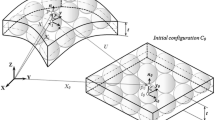Conclusions
-
1.
Maximum tensile stresses in the shells develop in a strip on the inner surface of the dome.
-
2.
The impact strength of the shells as a function of impact velocity can be estimated from the computed curves presented in Figs. 6 and 8.
-
3.
The theory of collisions between massive bodies within the framework of Hertz assumptions yields an impact-force value appreciably on the high side; in this case, the discrepancy increases with increasing impact velocity.
Similar content being viewed by others
Literature Cited
T. J. Hughes, R. L. Taylor, J. L. Sackman, et al., “A finite-element method for a class of contact-impact problems,” Comput. Methods Appl. Mech. Eng., No. 8, 249–276 (1976).
K. J. Bate and E. A. Wilson, Numerical Methods of Analysis and the Finite-Element Method [Russian translation], Stroiizdat, Moscow (1982).
J. D. Stachiw and O. H. Burnside, “Acrylic plastic spherical shell windows under point impact loading,” Trans. Am. Soc. Mech. Eng., Ser. B,98, No. 2, 563–575 (1976).
M. A. Senyushchenkov, “Statement of the dynamic contact problem of the finite-element method in accordance with an implicit scheme and an algorithm for its solution,” in: Role of Young Scientists and Specialists in Promoting Scientific and Technical Progress in Railroad Transportation: Theses of Papers [in Russian], Part 4, Vsesoyuznyi Nauchnoissledovatel'skii Institut Zheleznodorozhnogo Transporta, Moscow (1984), p. 39.
N. N. Shaposhnikov, R. A. Rimskii, G. V. Poltorak, and V. B. Babaev, “Application of the finite-element method to solution of dynamic problems,” Raschety Prochn., No. 23, 73–86 (1982).
N. N. Shaposhnikov, N. D. Tarabasov, V. B. Petrov, and V. I. Myachenkov, Strength and Stiffness Computation for Machine-Building Components [in Russian], Mashinostroenie, Moscow (1981).
O. Zenkevich and I. Chang, Finite-Element Method in the Theory of Structures and in Continuum Mechanics [Russian translation], Nedra, Moscow (1974).
M. A. Senyushchenkov, “Stressed state of thin-walled shells of revolution with a spherical dome under local static loading,” Moscow Institute of Railroad Transport Engineers, Moscow (1984), p. 24, Manuscript deposited in the All-Union Institute of Scientific and Technical Information, Depository No. 2498.
M. A. Senyushchenkov, “Numerical analysis of the stress-strain state of thin-walled axisymmetric elastic shells subjected to a local impulse,” Moscow Institute of Railroad Transportation Engineers, Moscow (1984), p. 25, Manuscript deposited in the All-Union Institute of Scientific and Technical Information, Depository No. 2497.
S. P. Timoshenko and J. N. Goodier, Theory of Elasticity, McGraw-Hill (1970).
Additional information
Moscow Institute of Railroad Engineers. Translated from Problemy Prochnosti, No. 6, pp. 73–77, June, 1985.
Rights and permissions
About this article
Cite this article
Senyushchenkov, M.A. Using the finite-element method to solve the dynamic contact problem for brittle axisymmetric shells on impact with an obstacle. Strength Mater 17, 816–822 (1985). https://doi.org/10.1007/BF01528735
Received:
Issue Date:
DOI: https://doi.org/10.1007/BF01528735




